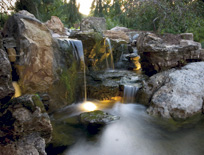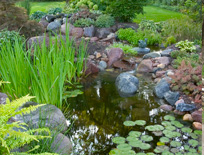pond design
For the pond-building artist, stone is the paint — and how it is used can make or break the look of a watergarden. Choosing the perfect stone, however, is no guarantee of a beautiful outcome. That’s the realm where creativity and inspiration from
Oddly enough, this story takes place in a down economy and shows how, despite perceived financial limitations, something surprising and wonderful can happen when people put their minds to it. For years now, my work at Aquascape (St. Charles, Ill.) has largely focused on developing, designing and installing systems that in one or more ways are environmentally sound and beneficial. In early 2009, I began working on a plan for a prototype community designed around optimal use of its resources, especially water. I imagined a town filled with rainwater-capturing systems, permeable surfaces and efficient irrigation. It included nothing but indigenous plants, was organized with minimal turf areas and set aside space for composting and cooperative organic farming. As for the homes, all of them boasted various resource- and energy-efficient features. The overall concept was so
Whether you’re installing a small residential watergarden or a large commercial pond, the key to producing one that is both natural-looking and easy to plant is largely determined by how you design
Despite our fondest desires, it’s quite inevitable that most of the things we humans design and build are impermanent and will change. That’s particularly true of the greenery we place in and around our gardens and watershapes, simply because plants grow and gradually alter the settings they surround or inhabit. There’s a measure of melancholy in this evolution: As designers and installers of these spaces, we’re left to recognize that in most cases we will never see them at their best and most beautiful. Yet that’s as it should be, because any living work of art will continue to develop and improve long after it is technically “completed” by our hands. There’s also great joy in creating naturalistic watershapes and garden spaces, because I see the art of finishing as an exercise in setting the table for the future. In fact, I see this as being remarkably empowering: By participating in
We recently completed a project that truly thrilled a pair of well-traveled, highly educated clients: It was a large, complex waterfall-and-pond composition in the sloping backyard of an upscale home in an affluent southern California neighborhood. There were a number of reasons why the project worked so well, but if I had to break it down to one thing more than any other, it had to do with the range of edge treatments we used within the available space. On the side nearest the house, we established a clean lawn-meets-water detail – very disciplined in appearance and obviously man-made. Directly across the pond was a set of rugged waterfalls – much wilder and basically untamed. Bracketing those features, we filled shallow areas with emergent plants and hiding places for fish and frogs. It was a well thought out plan, certainly right for the space. But I know for a fact that
Only three percent of the world’s water exists as fresh water – that is, water with low salinity and total dissolved solids of the sort found in lakes, rivers, reservoirs, ponds, streams and aquifers. It is arguably our most precious resource because, quite simply, we can’t get along without it. As populations grow around the world, the amount of fresh water available for drinking, irrigation, bathing and sanitation annually decreases on a per capita basis. These fresh-water supplies are replenished only by precipitation, so when droughts disrupt historical weather patterns, there’s trouble ahead – especially if the shortages hit highly populated areas. Today, it is estimated that one in six people on our planet lacks access to an adequate water supply. While the vast majority of those who endure this disadvantage live in other parts of the world, we in the United States are becoming more and more subject to supply shortages when localized droughts occur. Recent conditions in the southeastern United States are a prime illustration of what this entails: In Georgia, for example, water supplies recently hit 50-year lows. These conditions resulted in the imposition of all sorts of restrictions on water use, in some areas leading to bans on the installation of new watershapes. At Aquascape (St. Charles, Ill.), we’ve long believed that it’s our responsibility as professional watershapers to act responsibly in such circumstances, meaning in our case that
You never know where and when a good time will unfold. That thought certainly crossed my mind late in July, when I attended "The World's Most Extreme Pond Build" at Aquascape's headquarters in St. Charles, Ill. That company, which manufactures a variety of pond, stream and waterfall systems and accessories, has been remarkably successful through the past decade: In that span, it's built a
In December 2004, WaterShapes introduced ‘The Platinum Standard,’ a registry of projects that embodies watershaping…





















